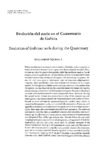Mostrar o rexistro simple do ítem
Evolución del suelo en el Cuaternario de Galicia
| dc.contributor.author | Díaz-Fierros Viqueira, Francisco (1941-) | |
| dc.date.accessioned | 2010-01-22T13:23:31Z | |
| dc.date.available | 2010-01-22T13:23:31Z | |
| dc.date.issued | 1995 | |
| dc.identifier.citation | Cadernos do Laboratorio Xeolóxico de Laxe, 1995, 20: 231-252 ISSN: 0213-4497 | es_ES |
| dc.identifier.issn | 0213-4497 | |
| dc.identifier.uri | http://hdl.handle.net/2183/6201 | |
| dc.description.abstract | [Abstract] When attempting to reconstruct the evolution of Galician soils, it is useful to make a distinction between the two types ofevidence currently available. First, we have soil data for geomorphologicalIy stable flat landforms (such as fluvial terraces, abrasion platforms and tertiary basins), which can be assumed to have remained more or less unchanged throughout the Quaternary. In general, the data for such sites provide information only on long-term edaphogenetic processes. More specificalIy, these data indicate the existence of two major periods. The first period probably lasted until about the start ofthe Mindel-Riss intergalcial, and was characterized by a relatively warm dry climate: during this period, changes in iron form distribution(and consequent changes in soil colour) occurred, with the formation ofchromic and possibly ferralic horizons. During the second period, climate was more similar to that of the presente day, and edaphogenesis was characterized by the formation ofargic and cambic horizons. Second, we have soil data for geomorphologicalIi unstable sites, subject to vegetation/devegetation cycles, and at which the alternation of erosional and aggradational phases can be expected to have given rise to shorter edaphogenetic cycles. Most such soils were formed since the Würm glaciation. The extensive information which has been accumulated in recent years on polIen spectra and deposit age has alIowed much more precise characterization of edaphogenesis over this periodo Data ofthis type indicate that, after the Würm (during which morphogenesis predominated over edaphogenesis), a long period of stability commenced, and that this period lasted until the climatic optimum of the . Atlantic subperiod, leading to the formation of cambic horizons. The onset of human deforestation activity, together with periodic climatic deteriorations, gave rise to successive erosional periods separated by short periods of stability and edaphogenesis (during which A and e horizons were probably formed). Over the period 3000-2500 BP, alterations in hydrological conditions evidently occurred, leading to the formation ofpeat bogs and gleic horizons. Sorne spodic horizons dating from about this time could have been formed as a result of the combined influence of climate and human activity. | |
| dc.language.iso | spa | es_ES |
| dc.publisher | Universidade da Coruña | es_ES |
| dc.subject | Paleosoils | es_ES |
| dc.subject | Soil formation | es_ES |
| dc.subject | Erosion quaternary ecology | es_ES |
| dc.title | Evolución del suelo en el Cuaternario de Galicia | es_ES |
| dc.title.alternative | Evolution of Galician soils during the Quaternary | |
| dc.type | info:eu-repo/semantics/article | es_ES |
| dc.rights.access | info:eu-repo/semantics/openAccess |






